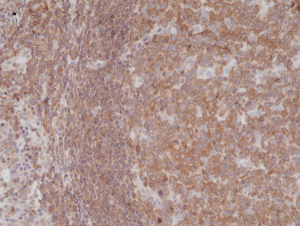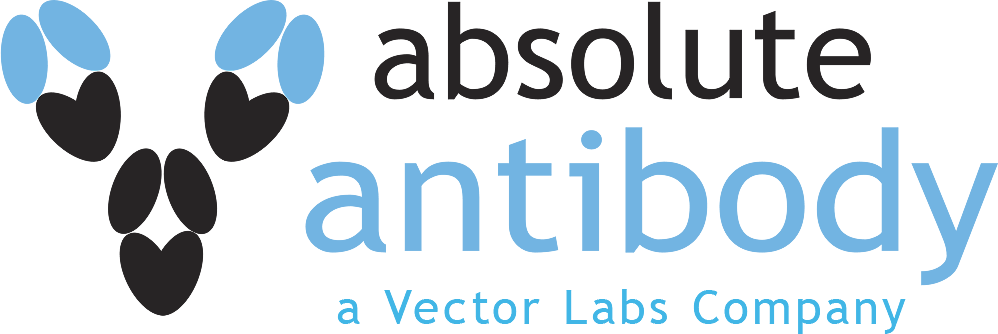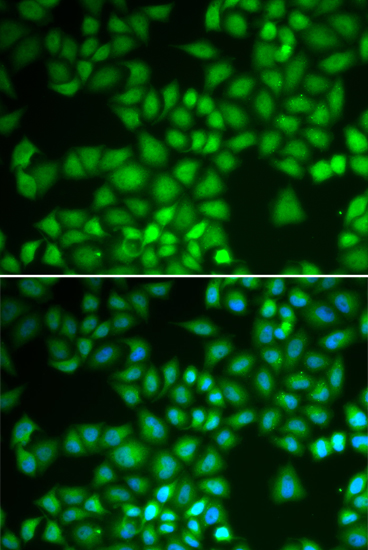
Immunohistochemical staining of formalin fixed and paraffin embedded human tonsil tissue section using anti-NF-kappa-B p105/p50 rabbit monoclonal antibody (clone RM299) at a 1:200 dilution.
anti-NF-kappa-B p105/p50 (human), Rabbit Monoclonal (RM299)
REV-31-1184-00
ApplicationsWestern Blot, ImmunoHistoChemistry
Product group Antibodies
ReactivityHuman
TargetNFKB1
Overview
- SupplierRevMAb Biosciences
- Product Nameanti-NF-kappa-B p105/p50 (human), Rabbit Monoclonal (RM299)
- Delivery Days Customer10
- ApplicationsWestern Blot, ImmunoHistoChemistry
- CertificationResearch Use Only
- ClonalityMonoclonal
- Clone IDRM299
- Gene ID4790
- Target nameNFKB1
- Target descriptionnuclear factor kappa B subunit 1
- Target synonymsCVID12, EBP-1, KBF1, NF-kB, NF-kB1, NF-kappa-B1, NF-kappaB, NF-kappabeta, NFKB-p105, NFKB-p50, NFkappaB, nuclear factor NF-kappa-B p105 subunit, DNA-binding factor KBF1, nuclear factor NF-kappa-B p50 subunit, nuclear factor kappa-B DNA binding subunit, nuclear factor of kappa light polypeptide gene enhancer in B-cells 1
- HostRabbit
- IsotypeIgG
- Protein IDP19838
- Protein NameNuclear factor NF-kappa-B p105 subunit
- Scientific DescriptionNF-kappaB is a pleiotropic transcription factor present in almost all cell types and is the endpoint of a series of signal transduction events that are initiated by a vast array of stimuli related to many biological processes such as inflammation, immunity, differentiation, cell growth, tumorigenesis and apoptosis. NF-kappaB is a homo- or heterodimeric complex formed by the Rel-like domain-containing proteins RELA/p65, RELB, NFKB1/p105, NFKB1/p50, REL and NFKB2/p52. The heterodimeric p65-p50 complex is the most abundant complex. The dimers bind at kappaB sites in the DNA of their target genes and the individual dimers have distinct preferences for different kappaB sites that they can bind with distinguishable affinity and specificity. Different dimer combinations act as transcriptional activators or repressors, respectively. NF-kappaB complexes are held in the cytoplasm in an inactive state complexed with members of the NF-kappaB inhibitor (I-kappaB) family. In a conventional activation pathway, I-kappaB is phosphorylated by I-kappaB kinases (IKKs) in response to different activators, subsequently degraded thus liberating the active NF-kappaB complex which translocates to the nucleus. NF-kappaB heterodimeric p65-p50 and RelB-p50 complexes are transcriptional activators. The NF-kappaB p50-p50 homodimer is a transcriptional repressor, but can act as a transcriptional activator when associated with BCL3. - Recombinant Antibody. This antibody reacts to human nuclear factor NF-kappa-B p105 subunit and p50 subunit. It may also react to mouse or rat NF-kappa-B p105/p50, as predicted by immunogen homology. Applications: WB, IHC. Source: Rabbit. Liquid. 50% Glycerol/PBS with 1% BSA and 0.09% sodium azide. NF-kappaB is a pleiotropic transcription factor present in almost all cell types and is the endpoint of a series of signal transduction events that are initiated by a vast array of stimuli related to many biological processes such as inflammation, immunity, differentiation, cell growth, tumorigenesis and apoptosis. NF-kappaB is a homo- or heterodimeric complex formed by the Rel-like domain-containing proteins RELA/p65, RELB, NFKB1/p105, NFKB1/p50, REL and NFKB2/p52. The heterodimeric p65-p50 complex is the most abundant complex. The dimers bind at kappaB sites in the DNA of their target genes and the individual dimers have distinct preferences for different kappaB sites that they can bind with distinguishable affinity and specificity. Different dimer combinations act as transcriptional activators or repressors, respectively. NF-kappaB complexes are held in the cytoplasm in an inactive state complexed with members of the NF-kappaB inhibitor (I-kappaB) family. In a conventional activation pathway, I-kappaB is phosphorylated by I-kappaB kinases (IKKs) in response to different activators, subsequently degraded thus liberating the active NF-kappaB complex which translocates to the nucleus. NF-kappaB heterodimeric p65-p50 and RelB-p50 complexes are transcriptional activators. The NF-kappaB p50-p50 homodimer is a transcriptional repressor, but can act as a transcriptional activator when associated with BCL3.
- ReactivityHuman
- Storage Instruction-20°C
- UNSPSC12352203







